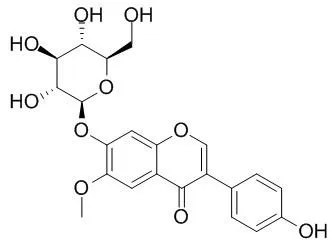| Description: |
Glycitin has antibacterial, antiviral, anti-obese,anti-diabetic and estrogenic activities and may exert preventative effects on alcoholism, osteonecrosis,cardiovascular and cerebrovascular diseases and some types of cancer. It has a protective effect on skin aging by inhibiting of MMP-1 and increasing of collagen through ERK/JNK/P38 down-regulation, shows good inhibitory effect on α-glucosidase with IC50 of 0.5646 mg/mL. |
| Targets: |
MMP(e.g.TIMP) | ERK | JNK | p38MAPK |
| In vitro: |
| Acta Pharmacol. Sin., 2005, 26(9):1081-6. | | Effects of genistein, daidzein and glycitein on the osteogenic and adipogenic differentiation of bone marrow stromal cells and on the adipogenic trans-differentiation of osteoblasts[Reference: WebLink] |
METHODS AND RESULTS:
The 3-(4, 5-dimethylthiazol-2-yl)-2, 5-diphenyl tetrazolium bromide (MTT), alkaline phosphatase (ALP) activity and oil red O assays were used to examine the effects of genistein, diadzein and glycitein on the osteogenic and adipogenic differentiation of primary mouse bone marrow stromal cells (MSCs) and the adipogenic trans-differentiation of primary mouse osteoblasts. The results indicated that daidzein, genistein and glycitein at concentrations from 1 × 10−8mol/L to 1×10−5 mol/L promoted the proliferation of MSCs and osteoblasts; genistein, daidzein and glycitein promoted osteogenic differentiation and inhibited adipogenic differentiation of MSCs, and inhibited adipocytic transdifferentiation of osteoblasts at appropriate concentrations as 17β-estradiol.
CONCLUSIONS:
It suggests that genistein, daidzein and glycitein regulate a dual differentiational process of MSCs into the osteogenic and adipogenic lineages, and trans-differentiational process of primary osteoblasts into the adipocyte lineages, causing a lineage shift toward osteoblast. Protective effects of them on bone may be mediated by a reversal of adipogenesis which may promote the proliferation, differentiation and mineralization of osteoblasts, and make adipocytes secrete less cytokines which may promote osteoclast formation and activation. In addition, the results also indicated that genistein, daidzein and glycitein may be helpful in preventing the development of steroid induced osteonecrosis. | | Exp Ther Med . 2016 Nov;12(5):3063-3067. | | Glycitin regulates osteoblasts through TGF-β or AKT signaling pathways in bone marrow stem cells[Pubmed: 27882117] | | Abstract
The aim of the present study was to examine the effect of Glycitin on the regulation of osteoblasts from bone marrow stem cells (BMSCs) through transforming growth factor (TGF)-β or protein kinase B (AKT) signaling pathways. BMSCs were extracted from New Zealand white rabbits and used to analyze the effect of Glycitin on BMSCs. BMSCs were cleared using xylene and observed via light microscopy. BMSCs were subsequently induced with Glycitin (0.01, 0.5, 1, 5 and 10 μM) for 7 days, and stained with Oil Red O. The mechanism of action of Glycitin on BMSCs was investigated, in which contact with collagen type I (Col I), alkaline phosphatase (ALP), TGF-β and AKT was studied. Firstly, BMSCs appeared homogeneously mazarine blue, and which showed that BMSCs were successful extracted. Administration of Glycitin increased cell proliferation and promoted osteoblast formation from BMSCs. Furthermore, Glycitin activated the gene expression of Col I and ALP in BMSCs. Notably, Glycitin suppressed protein expression of TGF-β and AKT in BMSCs. These results indicated that Glycitin may regulate osteoblasts through TGF-β or AKT signaling pathways in BMSCs.
Keywords: bone marrow stem cells; Glycitin; osteoblast; protein kinase B; transforming growth factor-β 1. |
|
| In vivo: |
| Biosci Biotechnol Biochem. 2015 Jan;79(1):117-23. | | Anti-obese and anti-diabetic effects of a mixture of daidzin and glycitin on C57BL/6J mice fed with a high-fat diet.[Pubmed: 25209298] |
METHODS AND RESULTS:
We investigated the effects of a mixture of daidzin and Glycitin, which are the glycoside-form isoflavones of daidzein and glycitein, respectively, on body weight, lipid levels, diabetic markers, and metabolism in a high-fat diet (HF) fed C57BL/6J mice for 92 days. The mice were divided into basic diet group (CON), HF group, and HF companied with the isoflavone mixture group (HFISO). Results showed that mice in HFISO had a significantly lower body weight and adipose tissue compared to HF group. Blood glucose, serum HbA1c, and serum insulin also showed lower levels in HFISO group. In addition, higher hepatic GSH level and lower serum 8-hydroxy-2'-deoxyguanosine (8-OHdG) level were found in HFISO group mice.
CONCLUSIONS:
This suggests that the regulation of oxidative stress by daidzin and Glycitin was closely related to the suppression of adipose tissue and the progression of diabetes. | | J. Korean Soc. App. Bi., 2014, 57(4):463-8. | | The Protective Effect of Glycitin on UV-induced Skin Photoaging in Human Primary Dermal Fibroblast[Reference: WebLink] | Exposure of strong and repeated UV on the skin leads to skin aging, characterized with wrinkling, sagging, dyspigmentation, and laxity. Numerous studies revealed that Matrix metalloproteinases are related to skin aging and functions as degrading enzyme of various types of collagen.
METHODS AND RESULTS:
Here, we attempted to evaluate the effectiveness of Glycitin (4'-hydroxy-6-methoxy-isoflavone-7-D-glucoside) on skin aging and mechanisms of action in UV-irradiated human dermal fibroblasts. Especially we focused on the expression of Matrix metalloproteinase-1 (MMP-1), which degrades procollagen type-I in dermis, by 3-(4,5-dimethylthiazol-2-yl)-2,5-diphenyltetrazolium bromide assay, Western blot, and reverse transcription polymerase chain reaction in cell lysates or media. Our results showed that Glycitin increased the viability of human dermal fibroblast and alleviated MMP-1 expression caused by UV irradiation. In addition, synthesis of type-I collagen was increased and UV-induced phosphorylation of ERK/JNK/p38 was decreased in dose-dependent manners. Taken together, we demonstrated that treatment with glycitein have a protective effect on skin aging by inhibiting of MMP-1 and increasing of collagen through ERK/JNK/P38 down-regulation, which may be mediated by the inhibition of ERK, JNK, and p38 mitogen-activated protein kinases.
CONCLUSIONS:
We suggest that Glycitin is a potential agent for the treatment of skin ageing. |
|






 Cell. 2018 Jan 11;172(1-2):249-261.e12. doi: 10.1016/j.cell.2017.12.019.IF=36.216(2019)
Cell. 2018 Jan 11;172(1-2):249-261.e12. doi: 10.1016/j.cell.2017.12.019.IF=36.216(2019) Cell Metab. 2020 Mar 3;31(3):534-548.e5. doi: 10.1016/j.cmet.2020.01.002.IF=22.415(2019)
Cell Metab. 2020 Mar 3;31(3):534-548.e5. doi: 10.1016/j.cmet.2020.01.002.IF=22.415(2019) Mol Cell. 2017 Nov 16;68(4):673-685.e6. doi: 10.1016/j.molcel.2017.10.022.IF=14.548(2019)
Mol Cell. 2017 Nov 16;68(4):673-685.e6. doi: 10.1016/j.molcel.2017.10.022.IF=14.548(2019)